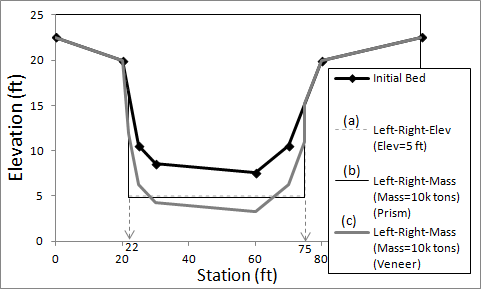Sometimes dredge mass is known and the geometry of the dredge cut is not known. This is often the case for in-channel aggregate mining where historical records and permits specify mass. The mass methods remove user specified sediment mass from the cross section. The four mass options offer flexibility to translate mass removal into cross section change.
Left–Right–Mass (Prism): This feature is analogous to the Left Sta–Right Sta–Elev method. Input the left and right stations that bound the dredge template in precisely the same way. However, instead of specifying an elevation, specify the mass removed from that cross section, and given the dredging extents, HEC-RAS will calculate elevation, removing material from a rectangular dredging template (Prism) that removes the specified mass.
Width-Mass (Prism): This feature is analogous to the Width–Elev feature. It centers the rectangular dredge cut between the channel banks, computing the bottom elevation that removes the mass from the specified width.
Left–Right–Mass (Veneer): This method is similar to Left–Right–Mass (Prism), except that dredged mass is no longer removed as a prism, but by the rules of the veneer method HEC-RAS uses to deposit and erode cross sections by other processes. HEC-RAS drops cross section nodes uniformly between the dredged limits (Right and Left) until cross section change reflects the dredged mass.
Width-Mass (Veneer): This method is identical to Left–Right–Mass (Veneer), except that instead of dropping bank stations uniformly between user specified left and right dredge limits, nodes are dropped if they fall within the specified with between the movable bed limits.

